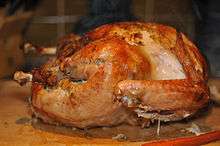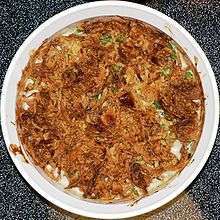Thanksgiving dinner
_Thanksgiving_Dinner.jpg)
The centerpiece of contemporary Thanksgiving in the United States and Canada is a large meal, generally centered on a large roasted turkey which is only enjoyed once per year. The majority of the dishes in the traditional American version of Thanksgiving dinner are made from foods native to the New World, as according to tradition the Pilgrims received these food from the Native Americans.[1]
Historical menus

According to what traditionally is known as "The First Thanksgiving," the 1621 feast between the Pilgrims and the Wampanoag at Plymouth Colony contained waterfowl, venison, fish, lobster, clams, berries, fruit, pumpkin, and squash. William Bradford noted that, "besides waterfowl, there was great store of wild turkeys, of which they took many."[2] Many of the foods that were included in the first feast (except, notably, the seafood) have since gone on to become staples of the modern Thanksgiving dinner. Early feasts of the Order of Good Cheer, a French Canadian predecessor to the modern Thanksgiving, featured a potluck dinner with freshly-hunted fowl, game, and fish, hunted and shared by both French Canadians and local natives.
The use of the turkey in the USA for Thanksgiving precedes Lincoln's nationalization of the holiday in 1863. Alexander Hamilton proclaimed that no "Citizen of the United States should refrain from turkey on Thanksgiving Day," and many of the Founding Fathers (particularly Benjamin Franklin) had high regard for the wild turkey as an American icon, but turkey was uncommon as Thanksgiving fare until after 1800. By 1857, turkey had become part of the traditional dinner in New England.[3]
A Thanksgiving Day dinner served to the Civilian Conservation Corps in 1935 included: pickles, green olives, celery, roast turkey, oyster stew, cranberry sauce, giblet gravy, dressing, creamed asparagus tips, snowflake potatoes, baked carrots, hot rolls, fruit salad, mince meat pie, fruit cake, candies, grapes, apples, clams, fish, and many other food harvests. French drip coffee, cigars and cigarettes.[4]
The White House Cook Book, 1887, by Mrs. F.L. Gillette, et al., had the following menu: oysters on half shell, cream of chicken soup, fried smelts, sauce tartare, roast turkey, cranberry sauce, mashed potatoes, baked squash, boiled onions, parsnip fritters, olives, chicken salad, venison pastry, pumpkin pie, mince pie, Charlotte russe, almond ice cream, lemon jelly, hickory nut cake, cheese, fruits and coffee.[5]
Turkey

Turkey is the most common main dish of a Thanksgiving dinner, to the point where Thanksgiving is sometimes colloquially called “Turkey Day.” In 2006, American turkey growers were expected to raise 270 million turkeys, to be processed into five billion pounds of turkey meat valued at almost $8 billion, with one third of all turkey consumption occurring in the Thanksgiving-Christmas season, and a per capita consumption of almost 18 pounds (8.2 kg).[6] The Broad Breasted White turkey is particularly bred for Thanksgiving dinner and similar large feasts; its large size (specimens can grow to over 40 pounds) and meat content make it ideal for such situations, although the breed must be artificially bred and suffers from health problems due to its size.
Most Thanksgiving turkeys are stuffed with a bread-based mixture and roasted. Sage is the traditional herb added to the stuffing (also called dressing if NOT cooked inside the bird), along with chopped celery, carrots, and onions. Other ingredients, such as chopped chestnuts or other tree nuts, crumbled sausage or bacon, cranberries, raisins, or apples, may be added to stuffing. Deep-fried turkey is rising in popularity due to its shorter preparation time, but carries safety risks.
The consumption of turkey on Thanksgiving is so ingrained in American culture that each year since 1947, the National Turkey Federation has presented a live turkey to the President of the United States prior to each Thanksgiving. These turkeys were initially slaughtered and eaten for the President's Thanksgiving dinner; since 1989, the presented turkeys have typically been given a mock "pardon" to great fanfare and sent to a park to live out the rest of their usually short natural lives.
Alternatives to turkey
Non-traditional foods other than turkey are sometimes served as the main dish for a Thanksgiving dinner. Ham is often served alongside turkey in many non-traditional households. Goose and duck, foods which were traditional European centerpieces of Christmas dinners before being displaced, are now sometimes served in place of the Thanksgiving turkey. Sometimes, fowl native to the region where the meal is taking place is used; for example, an article in Texas Monthly magazine suggested quail as the main dish for a Texan Thanksgiving feast. John Madden, who appeared on television for the NFL Thanksgiving Day game from 1981 to 2001, frequently advocated his fondness for the turducken, deboned turkey, duck and chicken nested inside each other then cooked.[7] In a few areas of the West Coast of the United States, Dungeness crab is common as an alternate main dish, as crab season starts in early November. Similarly, Thanksgiving falls within deer hunting season in the Northeastern United States, which encourages the use of venison as a centerpiece. Sometimes a fowl alternative to turkey is used; for example, goose or duck. Vegetarians or vegans may have a tofu, wheat gluten or lentil-based substitute; or stuffed squash. In Alaskan villages, whale meat is sometimes eaten. Irish immigrants have been known to have prime rib of beef as their centerpiece since beef in Ireland was once a rarity; families would save up money for this dish to signify newfound prosperity and hope.
In the United States, a globalist approach to Thanksgiving has become common with the impact of immigration. Basic "Thanksgiving" ingredients, or the intent of the holiday, can be transformed to a variety of dishes by using flavors, techniques, and traditions from their own cuisines. Others celebrate the holiday with a variety of dishes particularly when there is a crowd to be fed, guest's tastes vary and considering the financial means available.[8][9][10]
Side dishes


Many offerings are typically served alongside the main dish—so many that, because of the amount of food, the Thanksgiving meal is sometimes served midday or early afternoon to make time for all the eating, and preparation may begin at dawn or on days prior. Copious leftovers are also common following the meal proper.
Traditional Thanksgiving foods are sometimes specific to the day, and although some of the foods might be seen at any semi-formal meal in the United States, the meal often has something of a ritual or traditional quality. Many Americans would say it is "incomplete" without cranberry sauce, macaroni and cheese, stuffing or dressing, mashed potatoes, and gravy. Other commonly served dishes include winter squash and sweet potatoes, the latter often prepared with sweeteners such as brown sugar, molasses, or marshmallows. Fresh, canned, or frozen corn is popular and green beans, often served as green bean casserole, are frequently served. A fresh salad may be included, especially on the West Coast. Bread rolls or biscuits and cornbread, especially in the South and parts of New England, are served. For dessert, various pies are usually served, particularly pumpkin pie, though apple pie, mincemeat pie, sweet potato pie, and pecan pie are often served as well.
There are also regional differences as to the stuffing or dressing traditionally served with the turkey. The traditional version has bread cubes, sage, onion and celery. Southerners generally make their dressing from cornbread, while those in other parts of the country make stuffing from white, wheat or rye bread as the base. One or several of the following may be added to the dressing/stuffing: oysters, apples, chestnuts, raisins, and sausages or the turkey's giblets.
Other dishes reflect the region or cultural background of those who have come together for the meal. For example, Sauerkraut (among those in the Mid-Atlantic; especially Baltimore) is sometimes served. Many African Americans and Southerners serve baked macaroni and cheese and collard greens, along with chitterlings and sweet potato pie, while some Italian-Americans often have lasagne on the table and Ashkenazi Jews may serve noodle kugel, a sweet dessert pudding. Other Jewish families may consume foods commonly associated with Hanukkah, such as latkes or a sufganiyah; the two holidays are usually in close proximity and on extremely rare occasions overlap.[11] It is not unheard of for Mexican Americans to serve their turkey with mole and roasted corn. In Puerto Rico, the Thanksgiving meal is completed with arroz con gandules (rice with pigeon peas) or arroz con maiz (rice with corn), pasteles (root tamales) stuffed with turkey, pumpkin-coconut crème caramel, corn bread with longaniza, potato salad, roasted white sweet potatoes and Spanish sparkling hard cider. Turkey in Puerto Rico is stuffed with mofongo. Cuban-Americans traditionally serve the turkey alongside a small roasted pork and include white rice and black beans or kidney beans. Vegetarians or vegans have been known to serve alternative entree centerpieces such as a large vegetable pie or a stuffed and baked pumpkin or tofu substitutes. Many Midwesterners (such as Minnesotans) of Norwegian or Scandinavian descent set the table with lefse.
Beverages
The beverages at Thanksgiving can vary as much as the side dishes, often depending on who is present at the table and their tastes. Spirits or cocktails sometimes may be served before the main meal. On the dinner table, unfermented apple cider (still or sparkling) or wine are often served. Pitchers of sweet tea can often be found on Southern tables. Beaujolais nouveau is sometimes served, and the beverage has been marketed as a Thanksgiving drink since the producers of the wine (which is made available only for a short window each year) set the annual release date to be one week before Thanksgiving beginning in 1985.
References
| Wikimedia Commons has media related to Thanksgiving dinner. |
- ↑ Dickson, James G. (1992). The Wild Turkey: Biology and Management. National Wild Turkey Federation. Harrisburg, PA: Stackpole Books. p. 10. ISBN 978-0-8117-1859-2.
- ↑ Bradford, Of Plymouth Plantation 1620–1647, p. 100.
- ↑ Davis, Karen (2001). More Than a Meal: The Turkey in History, Myth, Ritual, and Reality. New York: Lantern Books. p. 53. ISBN 978-1-930051-88-1.
- ↑ Smith, Kathy M. (2001). Gold Medal CCC Company 1538: A Documentary. Paducah, KY: Turner Pub. Co. p. 98. ISBN 978-1-56311-642-1.
- ↑ "The Project Gutenberg eBook of The White House Cookbook, by Mrs. F.L. Gillette & Hugo Ziemann". Gutenberg.org. 2004-11-02. Retrieved 2014-02-13.
- ↑ Briggs, Mike (July 17, 2006). "Regional Farm Bill field hearing: Cape Girardeau, MO". U.S. Senate Committee on Agriculture, Nutrition & Forestry.
- ↑ Hart, Jay (2012-11-21). "Boom! Catching up with John Madden to talk all things ... turducken | Shutdown Corner – Yahoo Sports Canada". Ca.sports.yahoo.com. Retrieved 2014-02-13.
- ↑ Duffy, Gillian (November 4, 2007). "The Globalist's Thanksgiving". New York Magazine. Retrieved 2010-11-24.
- ↑ Wang, Frances Kai-Hwa (November 22, 2009). "Creating our own multicultural Thanksgiving traditions". AnnArbor.com. Retrieved 2010-11-24.
- ↑ Bo (November 19, 2007). "The Day the Lees discovered Thanksgiving". 8Asians.com. Retrieved 2010-11-24.
- ↑ Scee, Timothy (October 4, 2013). Hanukkah Falls on Thanksgiving for the First Time Since 19th Century. Newzjunky.com. Retrieved October 6, 2013.